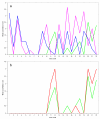The natural atypical scrapie phenotype is preserved on experimental transmission and sub-passage in PRNP homologous sheep
- PMID: 20219126
- PMCID: PMC2848638
- DOI: 10.1186/1746-6148-6-14
The natural atypical scrapie phenotype is preserved on experimental transmission and sub-passage in PRNP homologous sheep
Abstract
Background: Atypical scrapie was first identified in Norwegian sheep in 1998 and has subsequently been identified in many countries. Retrospective studies have identified cases predating the initial identification of this form of scrapie, and epidemiological studies have indicated that it does not conform to the behaviour of an infectious disease, giving rise to the hypothesis that it represents spontaneous disease.However, atypical scrapie isolates have been shown to be infectious experimentally, through intracerebral inoculation in transgenic mice and sheep. The first successful challenge of a sheep with 'field' atypical scrapie from an homologous donor sheep was reported in 2007.
Results: This study demonstrates that atypical scrapie has distinct clinical, pathological and biochemical characteristics which are maintained on transmission and sub-passage, and which are distinct from other strains of transmissible spongiform encephalopathies in the same host genotype.
Conclusions: Atypical scrapie is consistently transmissible within AHQ homozygous sheep, and the disease phenotype is preserved on sub-passage.
Figures




Similar articles
-
Experimental transmission of atypical scrapie to sheep.BMC Vet Res. 2007 Aug 28;3:20. doi: 10.1186/1746-6148-3-20. BMC Vet Res. 2007. PMID: 17725818 Free PMC article.
-
Phenotype shift from atypical scrapie to CH1641 following experimental transmission in sheep.PLoS One. 2015 Feb 24;10(2):e0117063. doi: 10.1371/journal.pone.0117063. eCollection 2015. PLoS One. 2015. PMID: 25710519 Free PMC article.
-
Atypical/Nor98 scrapie: properties of the agent, genetics, and epidemiology.Vet Res. 2008 Jul-Aug;39(4):19. doi: 10.1051/vetres:2007056. Epub 2008 Jan 11. Vet Res. 2008. PMID: 18187032 Review.
-
Transmissibility of atypical scrapie in ovine transgenic mice: major effects of host prion protein expression and donor prion genotype.PLoS One. 2009 Oct 6;4(10):e7300. doi: 10.1371/journal.pone.0007300. PLoS One. 2009. PMID: 19806224 Free PMC article.
-
Prion encephalopathies of animals and humans.Dev Biol Stand. 1993;80:31-44. Dev Biol Stand. 1993. PMID: 8270114 Review.
Cited by
-
Atypical/Nor98 scrapie infectivity in sheep peripheral tissues.PLoS Pathog. 2011 Feb 10;7(2):e1001285. doi: 10.1371/journal.ppat.1001285. PLoS Pathog. 2011. PMID: 21347349 Free PMC article.
-
Heart rate variability analysis in sheep affected by transmissible spongiform encephalopathies.BMC Res Notes. 2011 Dec 14;4:539. doi: 10.1186/1756-0500-4-539. BMC Res Notes. 2011. PMID: 22168827 Free PMC article.
-
A single amino acid residue in bank vole prion protein drives permissiveness to Nor98/atypical scrapie and the emergence of multiple strain variants.PLoS Pathog. 2022 Jun 22;18(6):e1010646. doi: 10.1371/journal.ppat.1010646. eCollection 2022 Jun. PLoS Pathog. 2022. PMID: 35731839 Free PMC article.
-
Clinical examination protocol to detect atypical and classical scrapie in sheep.J Vis Exp. 2014 Jan 19;(83):e51101. doi: 10.3791/51101. J Vis Exp. 2014. PMID: 24473217 Free PMC article.
-
Dysregulation of autophagy in the central nervous system of sheep naturally infected with classical scrapie.Sci Rep. 2019 Feb 13;9(1):1911. doi: 10.1038/s41598-019-38500-2. Sci Rep. 2019. PMID: 30760781 Free PMC article.
References
-
- Benestad SL, Sarradin P, Thu B, Schönheit J, Tranulis MA, Bratberg B. Cases of scrapie with unusual features in Norway and designation of a new type, Nor98. Vet Rec. 2003;153:202–208. - PubMed
-
- Loiacono CM, Thomsen BV, Hall SM, Kiupel M, Sutton D, O'Rourke K, Barr B, Anthenill L, Keane D. Nor98 scrapie identified in the United States. J Vet Diagn Invest. 2009;21:454–463. - PubMed
-
- Epstein V, Pointing S, Halfacre S. Atypical scrapie in the Falkland Islands. Vet Rec. 2005;157:667–668. - PubMed
-
- Bruce ME, Nonno R, Foster J, Goldmann W, Di Bari M, Esposito E, Benestad SL, Hunter N, Agrimi U. Nor98-like sheep scrapie in the United Kingdom in 1989. Vet Rec. 2007;160:665–666. - PubMed
Publication types
MeSH terms
Substances
LinkOut - more resources
Full Text Sources

